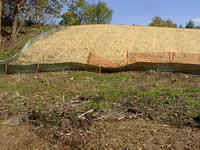Construction site storm water permits
The DNR’s construction site permit requires landowners to install practices to help decrease the amount of sediment that pollutes Wisconsin’s waterways from construction projects. Land disturbance during a construction project exposes bare soil which can erode during storm events. Practices help decrease the amount of sediment that runs off during a storm event.
- Wetland Screening and Delineation Resource for Construction Sites - Wetland Indicator Layers
-
On June 1, 2016, DNR’s Wetland Screening and Delineation Procedures guidance established a wetland screening process requiring customers applying for storm water, CAFO (Concentrated Animal Feeding Operations), and waterway and wetland permits to submit specific screening information with their application. The wetland indicator layers for this purpose were developed by the Department of Natural Resources and USDA Natural Resources Conservation Service (NRCS) to assist with making a preliminary determination of the potential for wetlands on a given property. Only a wetland professional can verify wetlands are present on a property.
Historically, the wetland indicator layer, commonly known as the “pink layer” was the only wetland indicator layer available on the surface water data viewer. This layer is being replaced by an updated layer, colored purple, to more accurately depict wetland potential. For the time being, the Wisconsin Department of Natural Resources (DNR) displays both Wetland Indicator layers on its Surface Water Data Viewer (SWDV) online: the “Maximum Extent Wetland Indicator” pink layer and the “Minimum Extent Wetland Indicator” purple layer. The agency is piloting the purple layer for screening accuracy. However, an error was found when the purple layer went live. The DNR’s wetland mapping team is working quickly to correct this issue.
To those who have already submitted an application based on the purple layer, DNR staff reviewing permit applications will continue to screen using the “Maximum Extent Wetland Indicator” pink layer. The agency also expects applicants to screen for wetlands based on the pink layer until further notice.
Erosion control plans contain specific practices to reduce erosion, divert storm water from disturbed or exposed construction site areas, and trap and control the transport of sediment and other pollutants. Construction site permits contain requirements for controlling erosion and storm water during construction as well as managing storm water runoff after construction is completed.
Photo by Pete Wood
- Permit overview
Information on construction site erosion control and storm water discharge permits, how to apply with a Notice of Intent (NOI), fees, and erosion control and storm water management plan requirements. - Apply for a permit and other forms
Access the Notice of Intent (NOI), download General Permit to Discharge Construction Site Storm Water Runoff - WPDES Permit No. WI-S067831, inspection forms, and Notice of Termination (NOT). - Find permit information
Search database for information on construction site applicants and permittees. - Publications/technical guidance
Obtain technical guidance on construction and post-construction Best Management Practices (BMPs). - View presentations
View presentations from past workshops on construction and post-construction management practices. - Standards/Models
Find information on technical standards for management practices and models. - Erosion Control and Storm Water Management Plans

